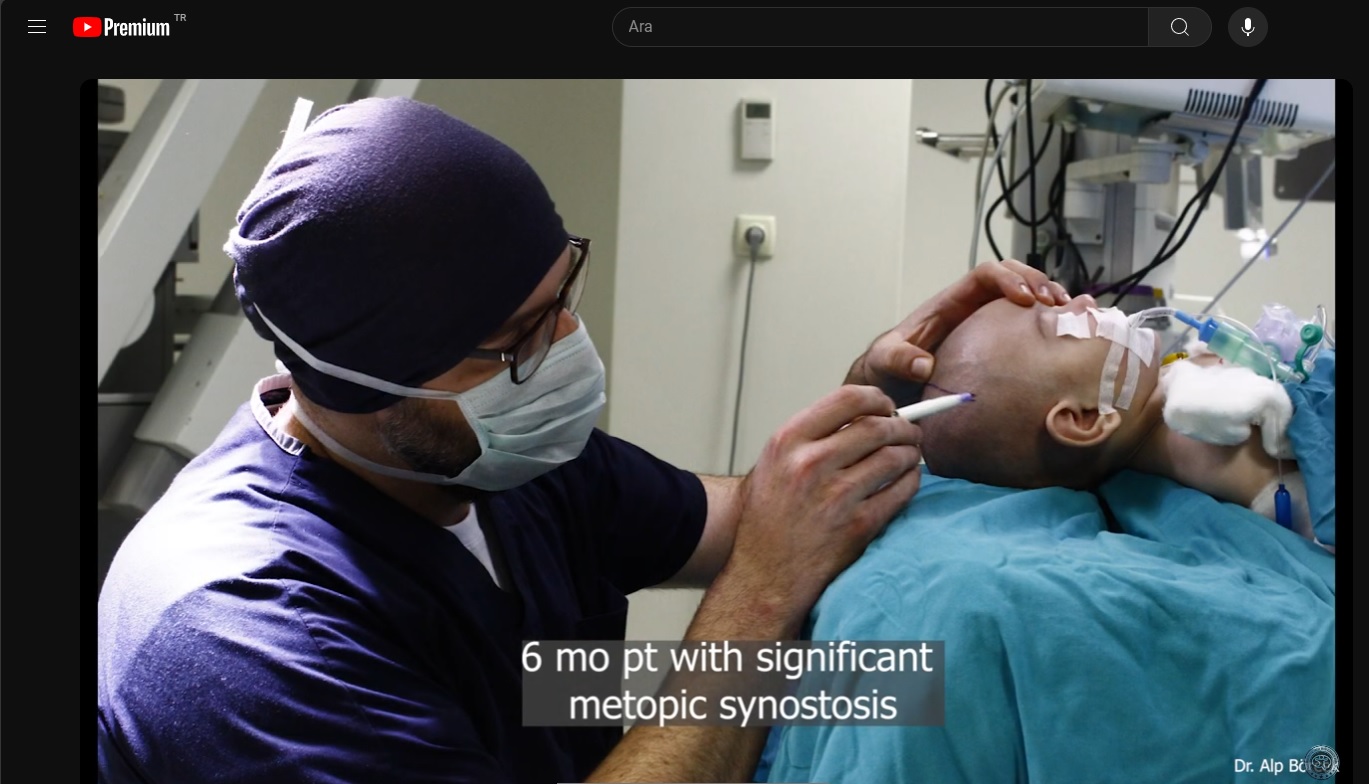Craniosynostosis
General Information, Symptoms, and Treatment
What is Craniosynostosis?
Craniosynostosis refers to the skull growth and shape problems that occur when one or more of the joints, sutures in the skull close prematurely. This condition is not uncommon, with approximately 1 in every 5000 births affected. It affects boys slightly more than girls. It is usually noticeable at birth and becomes more pronounced in the following months.
Patients with craniosynostosis may exhibit the following symptoms:
- Bulging at the front or back of the head
- A pointed ridge on the forehead
- Indentations at the temples
- Absence of the fontanel (soft spot)
- Uneven alignment of the eyes or eyebrows
- A palpable, firm ridge along the suture line on the skull surface

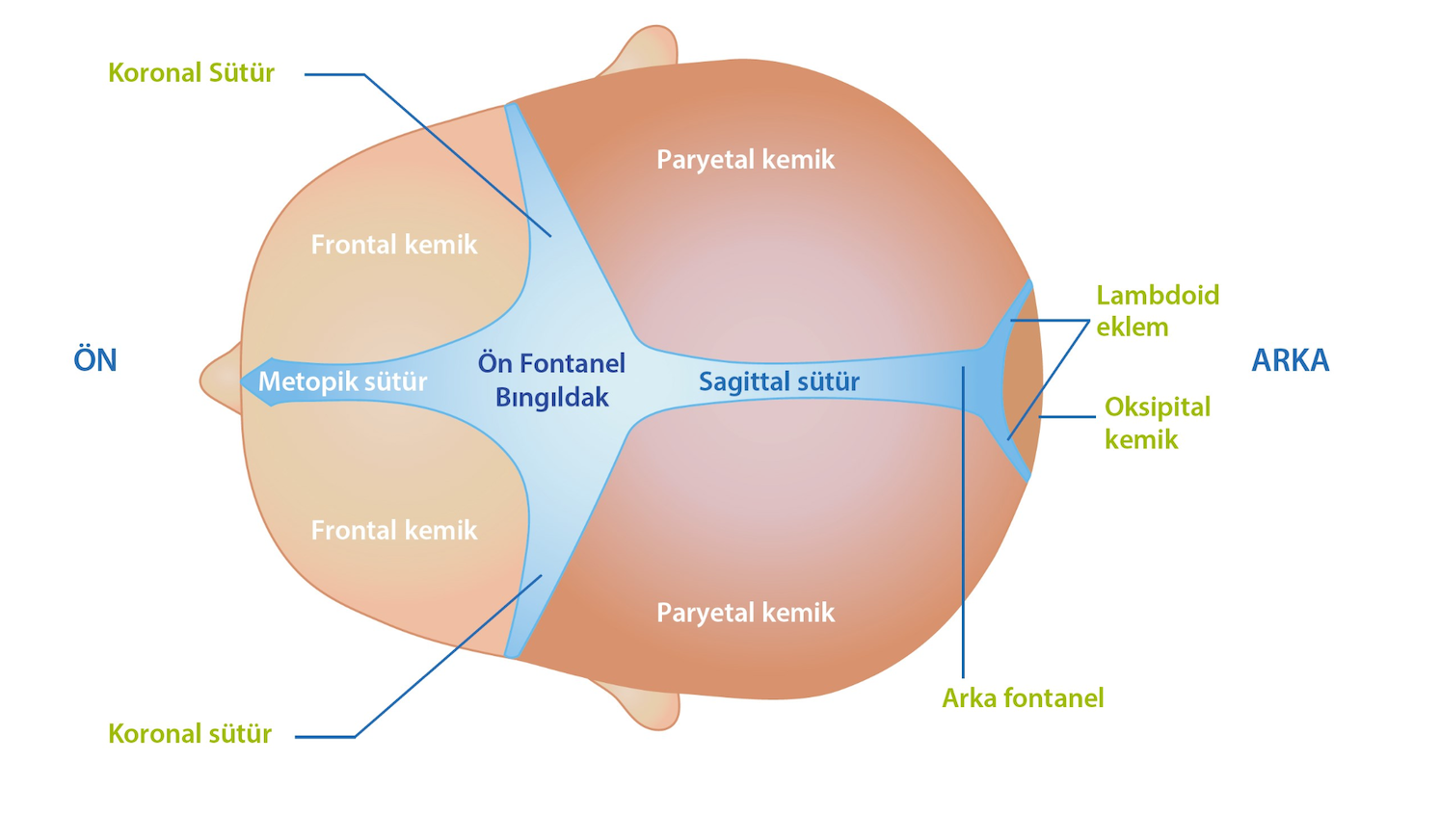
Newborn Skull Anatomy
Understanding craniosynostosis can be aided by knowing the anatomy of a newborn's skull. The skull is not formed by a single bone. It takes shape through the connection of several different bones joined by joints called sutures. The spaces between these joints are known as fontanelles or, more commonly, the soft spots. The image below shows the top view of a baby's skull.
The sutures are open when the baby is born. These openings allow the skull to grow over time. As the child ages, these joints close, and the skull takes on its adult shape. Each suture has a specific time frame for closure. For example, the rear fontanel usually closes within 1-2 months after birth, while the front fontanel may take 18-24 months to close. Sutures generally remain active until the child reaches adulthood, allowing the skull to grow along with the developing brain tissue inside.
What Causes Craniosynostosis?
The most important thing to know is that nothing you did caused this disease.
Medications you took during pregnancy, things you ate or drank, or any accidents you experienced are not related to this disease. In most cases, the cause of the disease is unknown. In some types (syndromic craniosynostosis cases), it is thought that certain known genetic disorders cause the disease.
Types of Craniosynostosis
There are many different types of craniosynostosis. They are named according to the type of affected suture. The most common types are shown in the adjacent diagram, with dashed lines representing the affected suture.
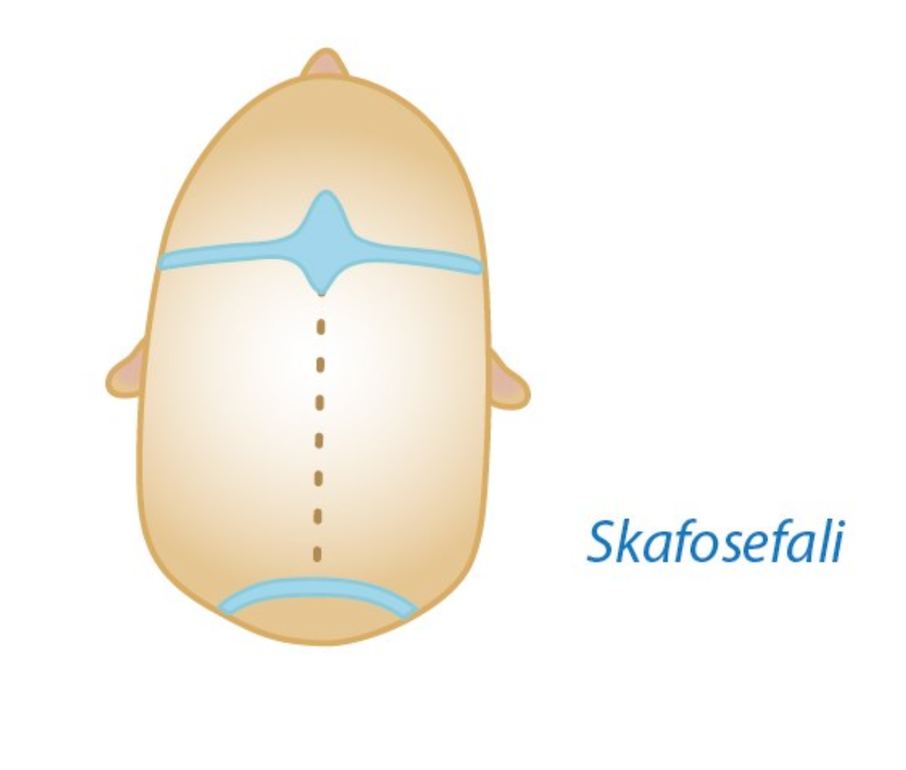
Scaphocephaly (sagittal synostosis): This is the most common type. The front-to-back diameter of the skull is increased. It occurs due to the premature closure of the sagittal suture in the middle of the skull.

Trigonocephaly (metopic synostosis): It occurs due to the premature closure of the suture in the forehead region. It causes the forehead to become pointed like the bow of a ship. The patient's eye sockets come closer together, creating a false appearance of strabismus.
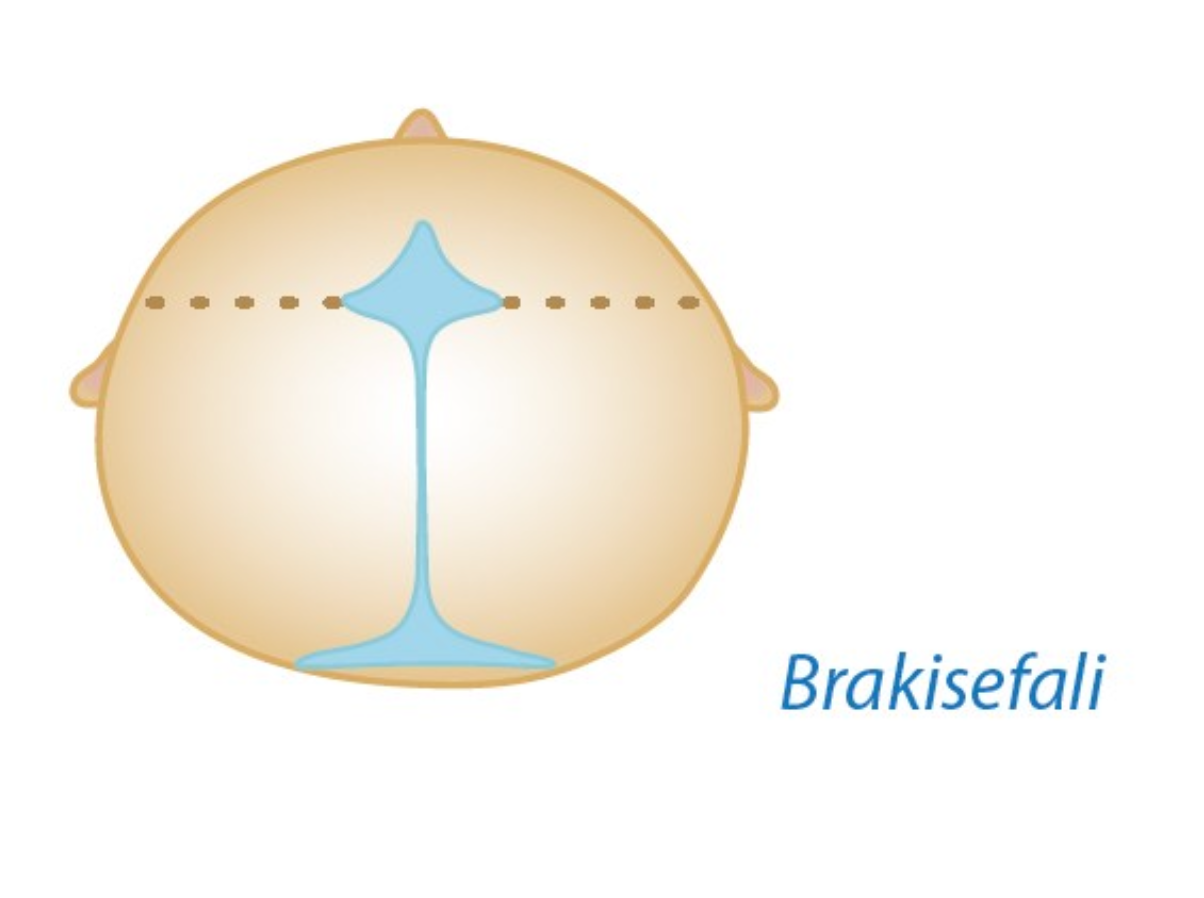
Brachycephaly (bicoronal synostosis): It occurs due to the closure of both coronal sutures. The head extends upward, and the forehead appears flat.
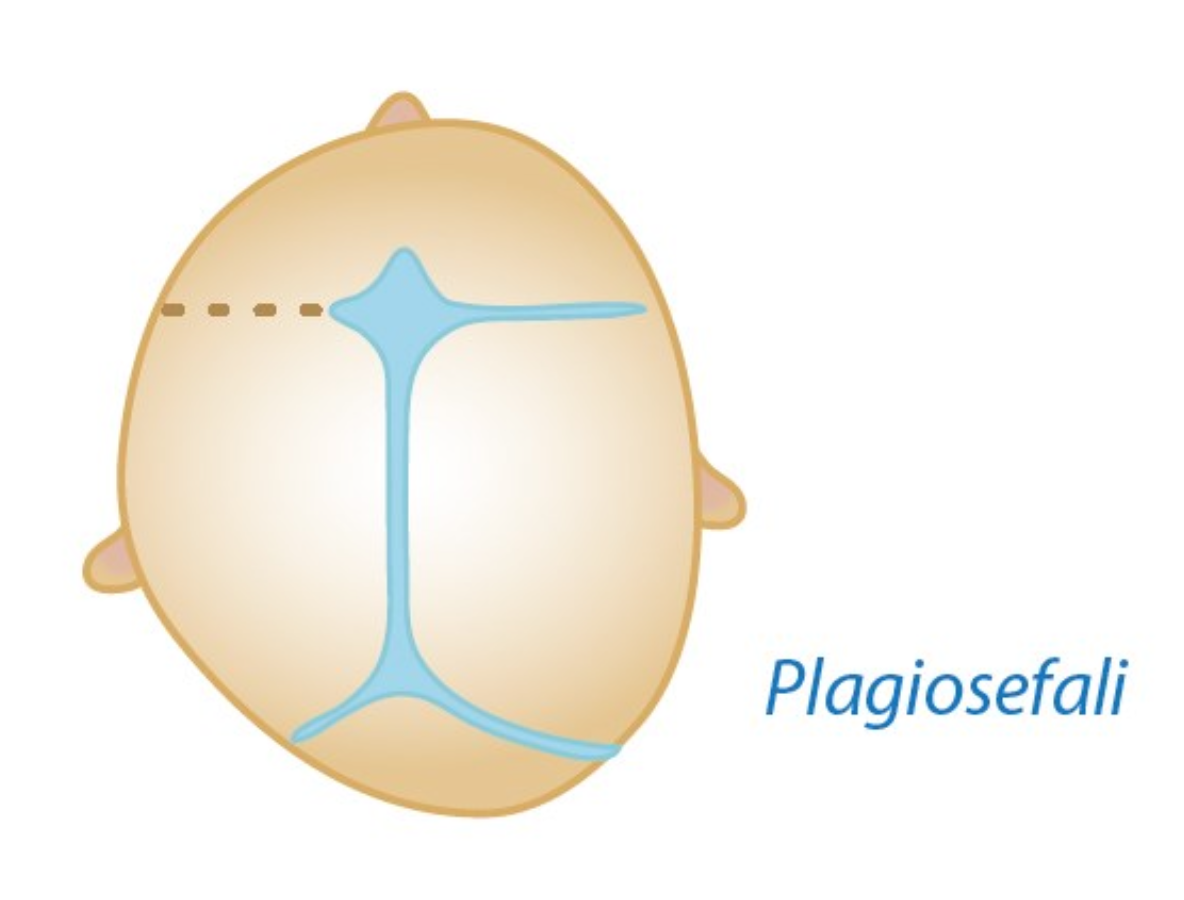
Plagiocephaly (unicoronal synostosis): It occurs due to the closure of a single coronal suture. It is one of the most problematic types in terms of aesthetics, causing deformity on one side of the head and downward displacement of the eye socket on the affected side.

Lambdoid synostosis (posterior plagiocephaly): This is quite rare. It occurs due to the closure of the lambdoid suture at the back of the head. Since it is under the hair, it may not cause significant cosmetic issues.
What are the Symptoms of Craniosynostosis?
The most noticeable symptom of craniosynostosis is the deformity of the skull. This deformity presents as an aesthetic — visual — problem. The severity of this symptom varies depending on the type of the disease. In some cases, the issue is only in the skull dome, while in others, there may be problems in the skull base, causing asymmetries in the face and eyes. These types are more challenging to treat and may require multiple surgical interventions.
Apart from this main symptom, the disease can have more serious symptoms. The most important of these is the potential increase in intracranial pressure due to the premature closure of skull sutures.
It should be noted that increased intracranial pressure is more common in types called syndromic, where multiple sutures are affected. However, it can also be seen, albeit rarely, with the closure of a single suture. This pressure increase can manifest in various ways, some of which are listed below:
- Persistent headaches
- Vision and eye problems
- Hearing problems
- Developmental delays
- Delayed speech
- Delayed walking
Is Surgery Necessary for Craniosynostosis?
The decision on whether a patient requires surgical intervention is made by evaluating many different factors. In our clinic, the decision for surgery is made together with the families. The main goal of surgery is to try to eliminate cosmetic — visible — problems.
Children can unknowingly subject a child with a skull deformity to bullying. Moreover, a child with a skull deformity may face psychological problems when they grow up and are unhappy with their appearance. The primary goal of surgery is to prevent the child from experiencing such issues.
The next most important goal is to prevent increased intracranial pressure and related problems, even though the risk is low. Scientific studies have shown that increased intracranial pressure can cause issues even in the simplest types of synostosis. However, these studies do not provide definitive information, and this topic remains one of the most debated in pediatric neurosurgery.

An internet-sourced image of a scaphocephaly patient
What Are the Types of Surgical Interventions for Craniosynostosis?
As with many areas of neurosurgery, there is unfortunately no method that is 100% guaranteed and certain. Doctors will usually offer you options based on the available facilities, the patient's condition, and their own training and experience. Every surgical method has its advantages and disadvantages. The best option will be the one decided with your doctor.
Endoscopic Surgery (Minimally Invasive Surgery): This type of surgery, which cannot be applied to all types of synostosis, achieves the best results in cases of sagittal synostosis and metopic synostosis. The most important parameter for this surgery is the patient's age. It is preferably performed on babies around 3 months old. Expected results may not be achieved in older children, and it is not performed after 6 months.
The biggest advantage of this type of surgery is that it is short, and the surgical wounds are small. The biggest disadvantage is the necessity of wearing a helmet post-surgery. The helmet is both costly (not covered by the social security system in our country) and somewhat cumbersome. It must be worn for about 23 hours a day for approximately 6 months. Additionally, cosmetic improvement is not immediate; it requires months, and in some types, years of correction.
Open Surgery: This is the standard surgical method that has been used for many years and can be applied to all types of synostosis. The surgery is preferably performed between 6-12 months, but it should be noted that the earlier it is done, the better the results will be.
The most significant disadvantages of this surgery are that it requires a large incision extending between both ears and that the surgeries are lengthy, lasting up to 4 hours (sagittal synostosis surgeries take about 2 hours). The most important advantage is that there is no need for helmet use after the surgery. Cosmetic improvement is immediately noticeable. The desired result is largely achieved around the 3rd month when the child's wounds have healed, and tissue swelling has completely subsided.
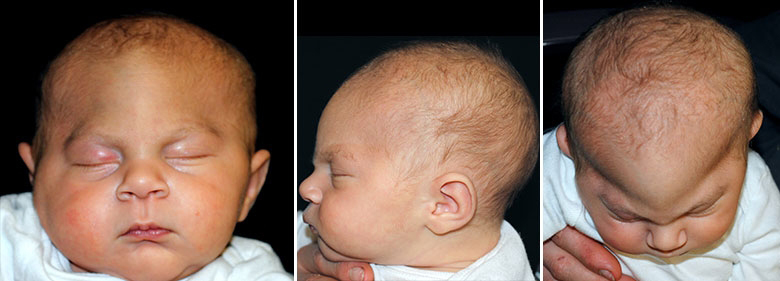
An internet-sourced image of a trigonocephaly patient
Are There Risks of Surgical Intervention?
Like any surgical and medical intervention, these surgeries also carry risks. Craniosynostosis surgery is a major operation performed on a small baby. The surgeries are lengthy, and there is blood loss during the procedure. Therefore, the most important factor in reducing surgical risks is the experience of the surgical team. The surgical team consists of neurosurgeons, plastic surgeons, pediatric anesthesiologists, and nurses. The most critical task falls to the anesthesia team, who ensure the baby receives proper care while under anesthesia for an extended period. The anesthesiologists manage vital indicators and procedures such as the child's temperature, the adjustment of medical fluids, and the measurement of urine output. With a good team, surgical risks are quite low.
The most common issues are those related to prolonged anesthesia and blood loss, which are usually resolved in the operating room. In addition, surgical problems such as wound site issues, discharge, infections, and suture openings may occur. These unwanted situations can sometimes be resolved on an outpatient basis, but they may occasionally require taking the patient back to the operating room. Since the surgery is fundamentally a skull surgery, not a brain surgery, brain function problems are not expected. The most feared life-threatening risk could occur if the above-mentioned issues cannot be resolved. The likelihood of such a severe situation occurring is very low.
Frequently Asked Questions
After the surgery, your child will have a large, turban-like dressing wrapped around their head. This dressing will extend from the lower part of the head, over the ears, and across the forehead. Your child's bed will be elevated at a 30-degree angle and will remain at this level until discharge. This is to support drainage from the surgical area and reduce swelling.
There will be a significant amount of fluid accumulation around the face and eyes, which you may hear referred to as "edema." Edema is a very normal response to a procedure like surgery. The body sends special blood cells to repair the skin and tissues that it senses have been disturbed. Your child will likely experience some swelling immediately after surgery. This is very normal and expected. Most children, especially if reshaping was done on the front part of the head, will be unable to open their eyes. Swelling peaks around the second day post-surgery and then gradually decreases. By the time the child is discharged from the hospital, the eyes are usually open. Any bruising that may accompany the swelling also subsides within the first week after surgery.
After surgery, your child will be taken to the intensive care unit (ICU). This is usually a precautionary measure rather than an indication of poor condition. In the ICU, the goal is to ensure the child fully awakens and begins feeding. Once the doctors deem it appropriate, your child will be moved to a regular hospital bed. Sometimes a night in the ICU is necessary, but generally, the child is moved to their room on the day of surgery. Your doctor will keep you informed at every stage, so there is no need to worry.
The length of the hospital stay generally depends on the reduction of facial edema, the child's feeding performance post-surgery, and the resolution of fever, which almost always occurs after major surgeries. Discharge usually takes place around the 4th or 5th day.
The reshaping procedure is generally well-tolerated by most children with minimal discomfort. Older children who undergo this procedure typically do not complain of pain. However, every individual's pain tolerance is different. Therefore, pain relief medications are available to manage any postoperative pain your child may experience.
